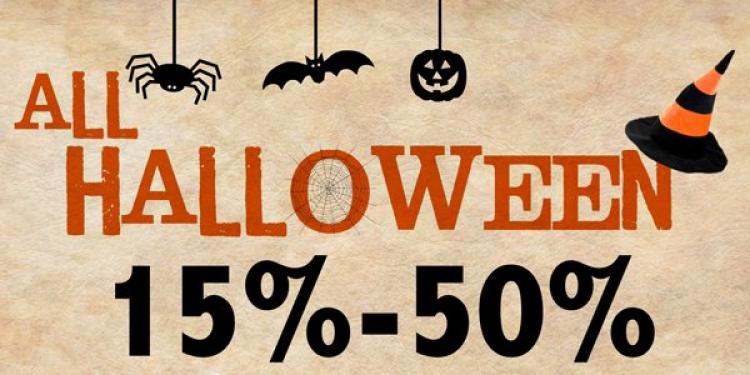Halloween Is A Safe Bet For Business
Posted: October 21, 2014
Updated: June 4, 2017

The commercial interests in Halloween reach into the billions of dollars and mark the beginning of a triple whammy of expensive holidays.
Celebrating the end of summer with a holiday that remembers the dead is a tradition stretching all the way back to when the end of summer significantly lowered the mortality rate. Celtic tribes would gather together as the first chill of winter set in, the summer season of trading and warfare having come to a seasonal close. To remember those lost over the course of the year, and perhaps by dint of that all the other dead people they knew, was a perfectly natural, very human, thing to do.
Three For The Price Of Lots
• Halloween spending to top 7.4 billion dollars
• Costumes for adults nearly 37% of expenditure
• US internet casino use imagery in promotions
Of course a Celtic celebration of any sort would involve drinking, story telling and a fair amount of story telling significantly effected by the amount of drinking that had gone on. This is why some of the more traditional Halloween tales, especially those about Witches, read like a collection of badly constructed mother-in-law jokes, and are easily imagined being told by a Celt slurring his words near the bonfire after a hard evening’s feasting.
Even the cautionary tales we tell to children at Halloween, stories that warn against greed, curiosity and straying from proper respect for the dead, authority in general and any adults they just happen to know well (parents), sound very much like the sort of inappropriately harsh, almost certainly complete bullshit, stories you fervently wish your brother wouldn’t tell your children around the dinner table after half a beer too much when he visits for family gatherings.
The Halloween we know today almost directly descends from a bunch of drunks remembering the faces of those that didn’t make it through the Summer and are now sadly absent, their spirits perhaps visiting for the party later that night. The creepy tales of horror and fear ensuring that children fearfully took to their tented beds rather than getting in the way of adults having the sort of fun adults have when they no longer have to concern themselves with the health and well-being of children.
One, Two, Three, You’re Out… Of Money
It is perhaps a tad ironic then, that from these innocent (albeit slightly sozzled) beginnings, that we have created a modern horror that rivals any of the tales told around the Celtic campfires of Samhain as the moon rose across the landscape. The slow development of the holiday, influenced by changing times and belief systems (Christianity has a lot to answer for), has now rendered unto us a veritable nightmare of consumerist capitalistic exploitation in which we’re caught like a deer in headlights.
Halloween, Thanksgiving and Christmas form a trifective of festivities in the western world, particularly the US, that begins around mid-October and doesn’t cease until the New Year sales have ebbed and flowed to an end. We are assailed with the symbolism of the season as it shifts and changes between the three, jack ‘o lanterns becoming turkeys becoming snowmen, both in terms of retail store displays, and in regards of the adverts we are bombarded with on television.
Even the internet gets in on the act with gambling sites in the US and elsewhere all featuring the images and icons of all three one after another with a gap between each you couldn’t fit a casino chip into. We are extolled to spend, spend and spend again, with a New Year retail temptation awaiting you and your hangover when the festivities are all done, so you can spend some more. The marketing men have leveraged our love for our children and families to part us from our cash thrice over – and then some.
This year in the US it is estimated that 7.4 BILLION dollars will be spent on Halloween celebrations, over 2.4 billion of that figure being spent on costumes alone (worryingly the majority of that by and for adults) which equals all the money that will be spent on Thanksgiving dinners but a few weeks later and is then entirely dwarfed by the trillions of dollars spent over and for the Christmas period. With so much money involved it is unsurprising corporate entities shove it down our throats like a string of sausages.
Counting The Cost
In times of economic boom (and are we not all gambling news of another boom will be along soon?) this is all well and good, but in circumstances of economic instability and indeed squeeze, can we really afford to spend quite so much on scaring our children and then giving them candy? A huge industry revolves around the holiday with profit margins entirely based on increasing the per capita expenditure of US citizens in the run up to this one time festival of fasting and prayer.
Supposedly each man, woman and child in the US consumes, on average, 1.8 kilos of pumpkin at Halloween, although methinks the figure includes that used up in the production of Jack ‘o Lanterns that is then spurned in favor of sweeter edibles. Consume is the watch word of this one time gathering of clans, with those not inclined to involve themselves often portrayed as Grouch-esque types who need to lighten up, as if the dead were disrespected by a lack of retail therapy on their part.
The holiday once observed as a mark of respect for those now departed (and possibly returning for supper tonight) has transgressed into an over indulgent sign-post marking the start of the nearly three-month long chain of excess and spending the end of the year has become. We hang a frightening mobile betting it will scare our neighbor’s children only to be far more horrified ourselves when the credit card bills arrive.
Halloween has seen many changes in both tone and content over the years. Feasting gave way to fasting and now has returned to excess, the tales of the supernatural have morphed into urban legends, and the memory of the dead now has a dollar price tag upon it that would make a drunken Celt revolve in his grave fast enough to power a medium sized town in Nebraska. We may not, in these modern times, be visited by spirits, ghosts and ghouls, but we’ll certainly be haunted by our finances come January.












